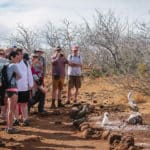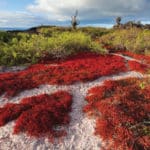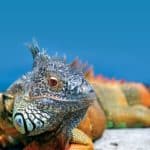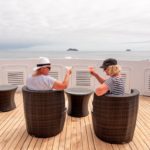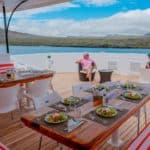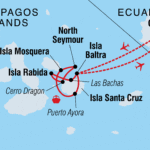Galapagos Explorer: Central Islands (Grand Queen Beatriz)
Explore the Galapagos and its native wildlife on a sailing trip around the central islands of the archipelago. Meet the green turtles that inhabit Isla Santa Cruz, watch blue-footed boobies dance the booby two-step and marvel in awe at the unfamiliar beauty that characterises these far-flung islands. Encounter the very same creatures that sparked Darwin’s imagination when he formulated his theories of evolution. There’s no spot on earth that is closer to the origins of the planet, where every step feels as though it’s through uncharted territory. Prepare to depart on the adventure of a lifetime and become a Galapagos explorer.
7 days, from
$2,818
per person
GROUP SIZE
ACTIVITY LEVEL
Details
Countries Visited:
Ecuador
Accommodation: Hotel (2 nights), Overnight boat (4 nights)
Transportation: Minibus , Boat , Plane , Zodiac
Included Meals:
- 6 breakfasts
- 4 lunches
- 5 dinners
Group size: Minimum 1, Max 16
As you board your vessel, M.Y Grand Queen Beatriz, and follow in the footsteps of Charles Darwin, you will encounter nature at its finest.
Explore the islands from on deck, on foot and in the water, no doubt with your eyes open for your next unique sight.
This is indeed the Galapagos journey with something for everyone.
Itinerary
On arrival at Quito's Mariscal Sucre International Airport you will be met and transferred to your hotel. The remainder of the day will be at your leisure.
A welcome meeting will be held in the evening at either 5pm or 6 pm when you meet others travelling with you on your cruise to the Galapagos Islands. Please check with hotel reception or check the reception notice boards for the time and place of the meeting for your trip. As today is an arrival day, you can arrive at any time as there are no activities planned until this important meeting.
If you can't arrange a flight that will arrive in time, you may wish to arrive a day early so you're able to attend. We'll be happy to book additional accommodation for you (subject to availability).
Quito sits at high altitude under the towering Pichincha volcano. It is a beautiful city, arguably one of the most beautiful in South America. The city stretches along the valley and is surrounded by the Andes. The Old Town of Quito is awash with history, with more than 30 churches to explore, and a number of fascinating museums. La Compania de Jesus is considered to be the most beautiful and ornate churches in the Americas. The city's oldest street, Calle La Ronda, is well worth exploring.
As this trip spends very little time in Quito, we recommend you spend a few extra days before or after your trip to experience all the city has to offer. You may even wish to explore further beyond the city and visit Otavalo, Cotopaxi, the Cloud Forest or the Equatorial Monument.
This morning you will be transferred to the airport for your flight to the Galapagos Islands. Please note the pick-up time will usually be as early as 4:30 am (a boxed breakfast will be provided), as the airport is a one-hour drive away and you must allow for delays and check-in times. (Your tour leader will confirm this time with you at the Welcome Meeting on Day 1).
A US$20 per person transit card is payable on departure at Quito Airport and a US$100 per person national park entry fee is payable on arrival on the islands. Please have cash on hand for these transactions as credit cards are not accepted.
The flight to the Galapagos will make one stop in Guayaquil to pick up other passengers. (Total flight time is about 3.5 hours).
On arrival in the Galapagos, you will be met in the arrival hall of the airport (look out for 'Grand Queen Beatriz' signs) by a transfer guide and transferred to our catamaran - ‘M/Y Grand Queen Beatriz’, anchored on the other side of Santa Cruz Island. Our transfer guide will take you on an airport public bus for a short distance (5 minute drive) to where you board a public ferry across the Itabaca Channel. The ferry crossing takes only 7 minutes. (Please note that all public transportation costs are included). Once you reach Isla Santa Cruz, a private bus you board a private bus for a 45-minute drive to Puerto Ayora, the main port of the island. Here, there will be two dinghies to transport you and your fellow travellers to the 'MY. Grand Queen Beatriz'. Once on board, cabins will be assigned and there will be a welcome briefing and safety drill. You will then get to meet our crew members and get to know your naturalist guide while enjoying a delicious lunch.
After lunch, head up into the highlands for a total change of scenery. Beginning at the coast you'll travel across Santa Cruz through the agricultural region and into the misty forests, with the walk taking about 45 minutes. This is a lush humid zone containing miconia bushes, scalesia and inactive volcanic cones. Santa Cruz has more endemic plants than any of the other islands, and you are likely to see Galapagos giant tortoises in their natural habitat and perhaps even the bright red feathers of a vermillion flycatcher!
Estimated travel time/distance:
Puerto Ayora to North Seymour: 4 hours (35 nautical miles)
Today you will take a morning excursion to North Seymour which is one of the most visited islands in the Galapagos. The trail on North Seymour crosses inland through the island and then explores the rocky coast. Along the way the trail passes colonies of blue footed boobies and frigate birds.
The magnificent frigate bird, a large black bird with a long wingspan, and a hooked beak, is extremely fast and has excellent vision. Frigate birds are known for the large red pouch on their necks. During mating season the males throw back their heads, inflate the pouch (sometimes to the size of a soccer ball), and shake trying to capture the attention of female frigates.
Boobies and frigates have an interesting relationship. Sharing the same nesting area on North Seymour, blue-footed boobies nest on the ground making their nests from the twigs of the palo santos trees, while the frigate birds nests just above them in the saltbushes. Your walk is followed by snorkelling where you will find a great variety of fish and possibly white-tipped reef sharks, rays and sea lions.
After lunch you will visit the small sandy island of Mosquera, a relaxing, picturesque stop situated between Baltra and North Seymour. Along the rocks and in the tide pool, Sally Lightfoot crabs (red lava crabs) scamper back and forth, skipping across small pools of water in search of food. These crabs with their bright red shell tops and blue under shells are stunning against the black lava. The island also has a very large colony of sea lions as well as a sizeable resident brown pelican population. Depending on the tides and visibility, you may have a chance to go snorkelling here.
Estimated travel time/distance:
North Seymour to Isla Baltra: 4 hours (35 nautical miles)
Isla Baltra to Caleta Tortuga: 1 hour (7 nautical miles)
Today you will take a morning excursion on a 'panga' to Caleta Tortuga Negra (Black Turtle Cove) - a red mangrove wetland on the north shore of Isla Santa Cruz. You will paddle among the cove’s peaceful waters, for your first taste of the underwater riches of this region – it’s a wonderful place to see green turtle and is a nursery for golden cow-nose rays, eagle rays and Galapagos sharks. There is also abundant birdlife, such as the yellow warbler and lava heron. This is also a breeding area for turtles, so it is not uncommon to see them mating.
In the afternoon, cruise over for a walk on Cerro Dragon (Dragon Hill) this afternoon - one of the best places to see land iguanas in the islands. From our dry landing we walk to a brackish lagoon frequented by lagoon birds including stilts, pintail ducks, sandpipers, sanderlings and occasionally flamingos. Further inland, the trail offers a beautiful view of the bay and the western area of the archipelago. This area is a nesting site for land iguanas, which is constantly monitored and assisted by the Charles Darwin Research Station. The arid-zone vegetation makes for a rewarding location for birdwatching with Darwin's finches, Galapagos mockingbirds, the endemic Galapagos flycatcher and yellow warblers all regulars here. The path can be challenging but you will be well-rewarded with a spectacular view of the bay!
Estimated travel time/distance:
Caleta Tortuga Negra to Cerro Dragon: 2 hours (12 nautical miles)
Cerro Dragon to Sombrero Chino: 1.5 hours (9 nautical miles)
Sombrero Chino is a small islet located near the south-east coast of Santiago. It's shaped like a Chinese hat (Sombrero Chino) when seen from afar, and is geologically fascinating, with many lava tubes leading from the cone to the coast. We approach Sombrero Chino via a beautiful crescent-shaped, sandy beach that is home to sea lions and Sally Lightfoot crabs. Opposite Sombrero Chino, on the rocky shoreline of nearby Santiago, Galapagos penguins are often seen. We follow a trail that circles the cove and passes through a sea lion colony and innumerable marine iguanas. The cove also offers some great snorkelling opportunities, hopefully with penguins and sharks.
Isla Rabida, also known as Jervis Island, is a tiny island sitting roughly five kilometres south of Santiago and is one of the most striking of the archipelago. Introduced species were eradicated in 1971, meaning that the indigenous wildlife has now been returned to a state of splendid isolation. Additionally, volcanic activity here has produced vivid, fantastical colours, not least the beaches of red sand and cliffs of scarlet.
From the shore, the trail leads through to what is one of the finest lagoons in the Galapagos for viewing flamingos. Rabida is also a wonderful place to spot nesting pelicans. Elsewhere, pintail ducks, marine iguanas and sea lions are all present. There is an opportunity for snorkelling in a place where sea stars, damsels, gobbies and surgeon fish are numerous.
Estimated travel time/distance:
Sombrero Chino to Isla Rabida: 1 hour (7 nautical miles)
Isla Rabida to Bachas Beach: 1 hour (7 nautical miles)
As flights to the mainland from Galapagos depart mid morning, it is an early start for our last morning on the islands. Depending on the time of our flight, our time spent on this final excursion could be limited.
As you will be leaving the boat this morning, please remember that if you have enjoyed the services provided by your guide and crew, a tip would be very much appreciated by them. As a guideline we recommend each passenger consider US$15 per day for the crew and US$10 per day for your guide. You can leave tips in envelopes that are placed in your cabin on the last day of your journey.
Today you will take an early morning excursion to Las Bachas, which was so named after the barges abandoned by the American Navy here in the 1940s. The sandy, white beaches of Las Bachas on the north shore of Santa Cruz Island are a nesting site for the Pacific green turtle, and marine iguanas are also commonly seen. The sand here is particularly white and soft as it is made of decomposed coral.
The rocks provide great snorkelling and are the perfect habitat for the Sally Lightfoot crabs, which are plentiful on the island. A saltwater lagoon near the beach is home to flamingo and whimbrel, and look out too for great blue herons. This is your final excursion before you return to the airport in Baltra for your flight back to Quito. The flight will stopover in Guayaquil to drop off/pick up new passengers.
Upon arrival in Quito Airport (approx. 4pm) you will be transferred back to your hotel for an overnight stay. Our local representative may stop by at your hotel this evening to get your feedback on your Galapagos experience.
Estimated travel times/distance:
Grand Queen Beatriz to Isla Baltra: 15 mins
Flight time Isla Baltra to Quito: approx 3.5 hours (including transit in Guayaquil)
Transfer Quito Airport to Hotel: 1 hour (depending on traffic)
Your Galapagos adventure will come to an end today after breakfast. There are no activities planned for the final day so you are able to depart the accommodation at any time. There are many fascinating things to do in and around Quito, so please speak to our customer service representative about any optional activities that might be of interest. They can also assist you in booking a departure transfer to the airport.
